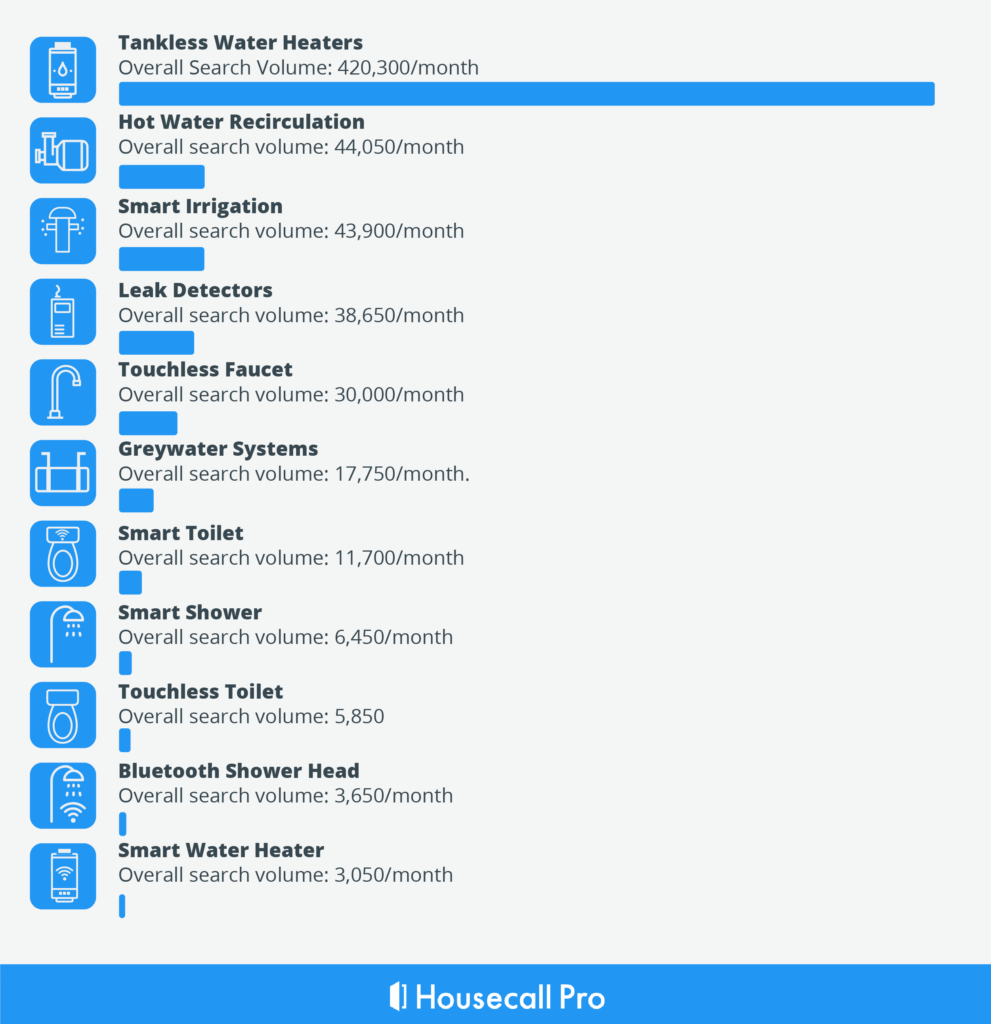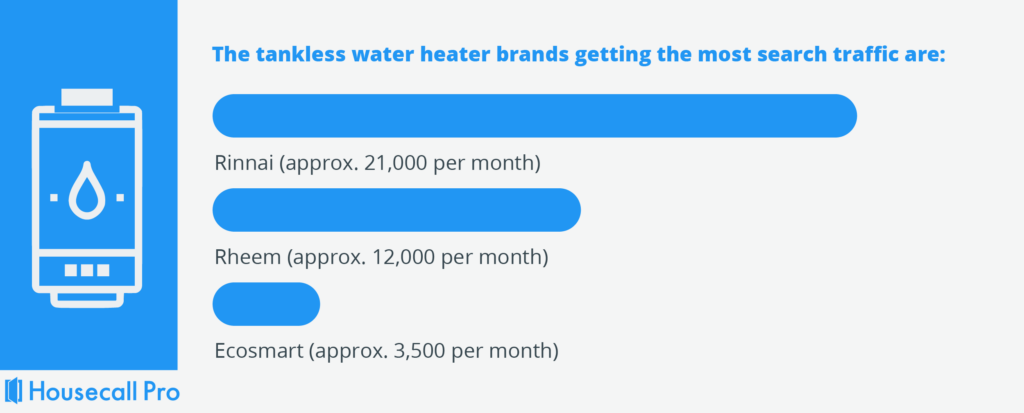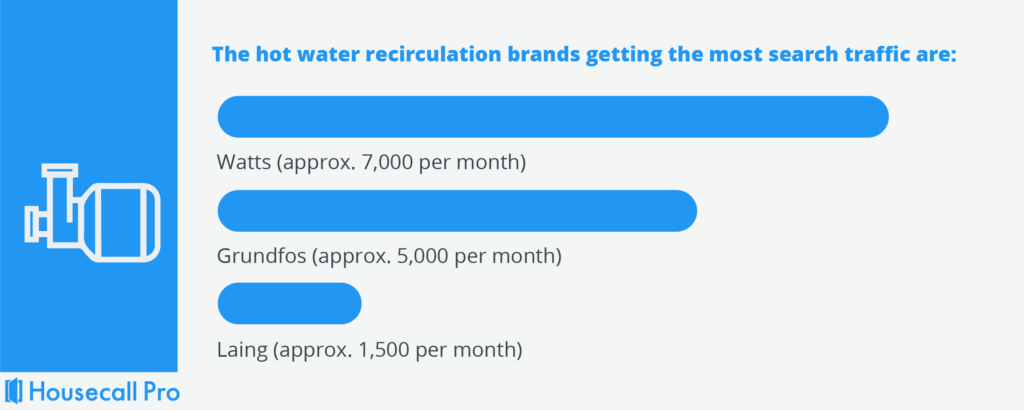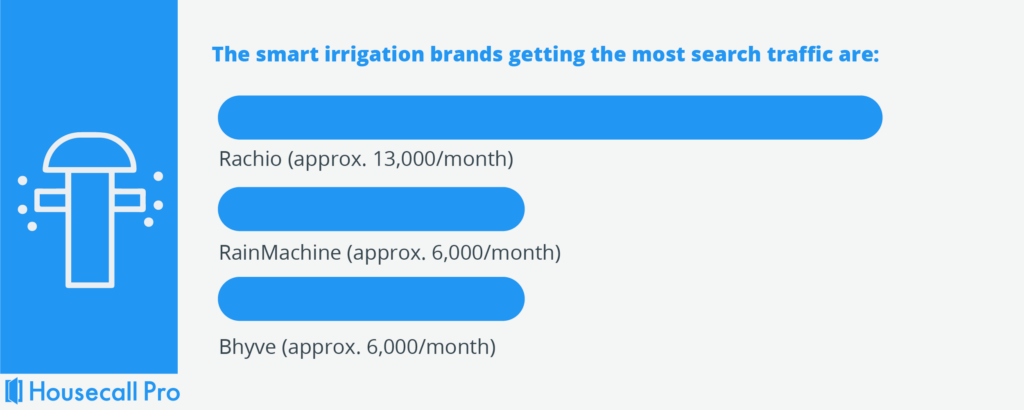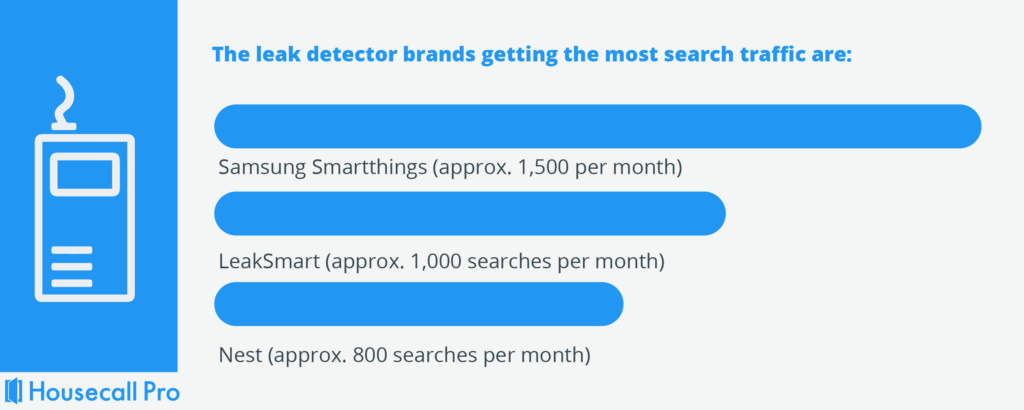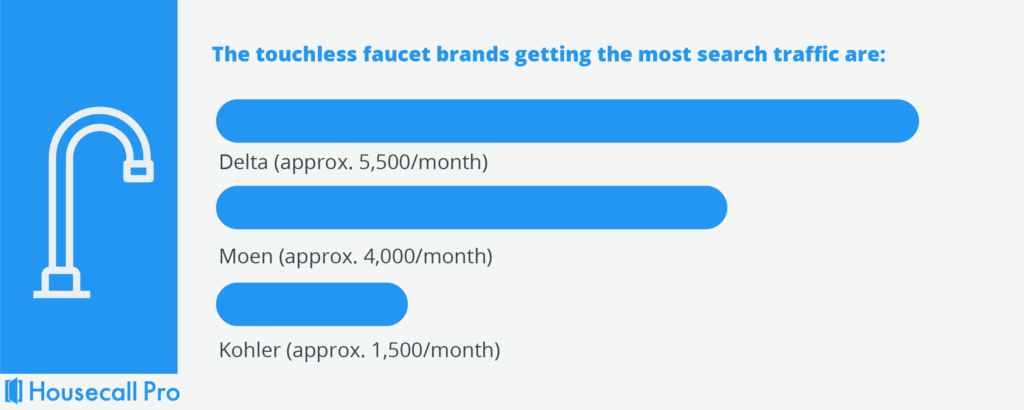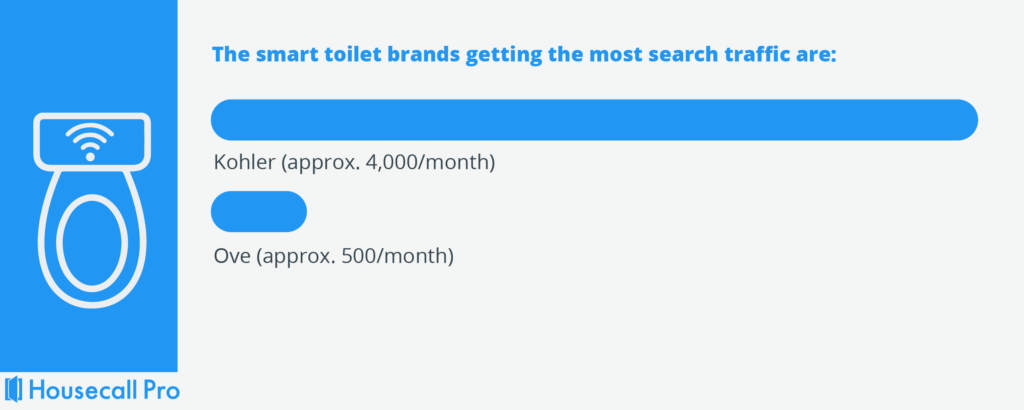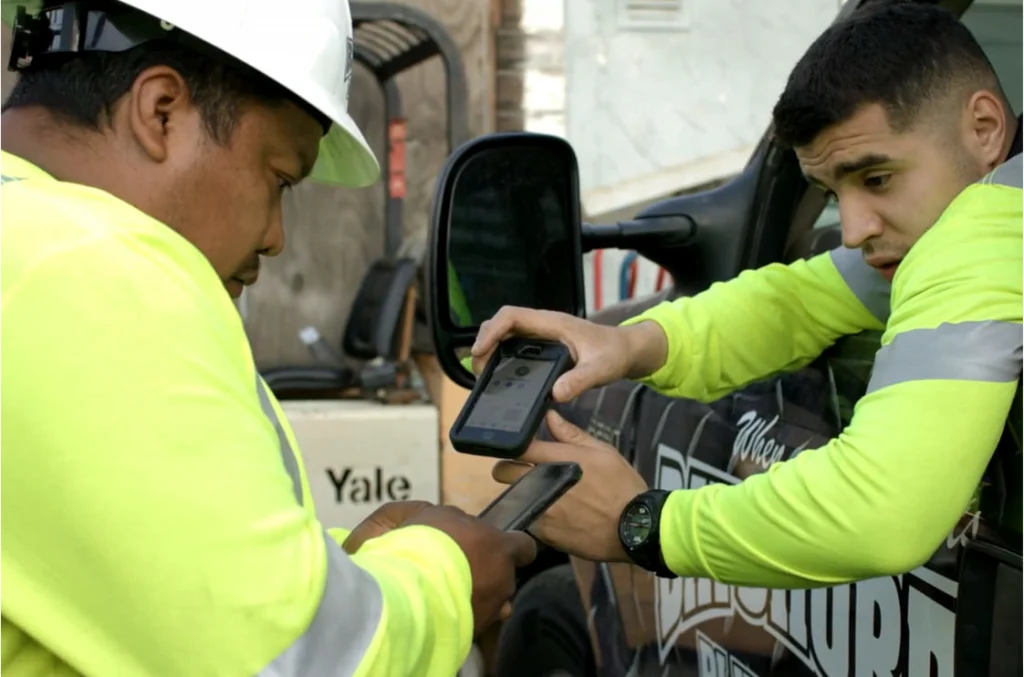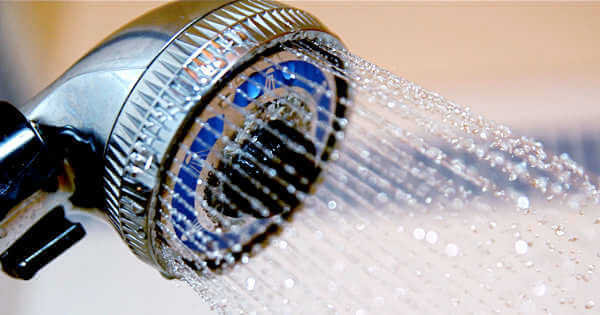
If you’re a plumber, knowing what products and new technologies beyond just plumbing software can be a tremendous boon to your business. After all, if you know what’s in demand, you can then offer those new products to your customers.
But how can you know which plumbing products and technologies are most in demand? That’s where we come in.
We scraped data from millions of plumbing-related Google searches to identify which plumbing technologies are in demand (assuming high search volume equals high demand). We then sorted, analyzed, and now present that data for your perusal.
We only included queries with “buyer intent” behind them. In other words, we only included queries that a person might enter if they were in the process of purchasing a product. We excluded queries that were primarily informational, such as, “How does a tankless water heater work?”
Use this data to help you understand the plumbing landscape as a whole, as well as what plumbing products and services you might offer to your customers.
Plumbing Technology #1: Tankless Water Heaters
Overall Search Volume: 420,300/month
By far, the technology getting the most Google searches every month is tankless water heaters. The searches include both electric and gas tankless water heaters, with each getting well over 20,000 searches per month.
A tankless water heater is, as you might guess, a water heater that does not use a tank. Rather, it heats the water as it flows through the tank, providing an endless supply of hot water.
The tankless water heater brands getting the most search traffic are:
- Rinnai (approx. 21,000 per month)
- Rheem (approx. 12,000 per month)
- Ecosmart (approx. 3,500 per month)
What’s clear from this data is that people want the convenience of never running out of hot water, which is exactly what a tankless water heater supplies. They want to be able to take long, luxurious showers without worrying whether the hot water will run out.
Additionally, consumers may be wanting to save on energy (and money). It’s an established fact that tankless water heaters can be significantly more energy efficient than standard hot water tanks. By using less energy, a tankless water tank benefits both the environment and the consumer’s wallet. If you are planning to get one, check out this list of tankless water heaters by Verellenhc.
Plumbing Technology #2: Hot Water Recirculation
Overall search volume: 44,050/month
Closely related to tankless water heaters is the concept of hot water recirculation. Hot water recirculation systems keep hot water constantly circulating through the pipes in order to provide hot water instantly.
Without a hot water recirculation system, water that was hot cools in the pipes, meaning that more water must be pumped through them (and go down the drain) in order to get hot water.
The hot water recirculation brands getting the most search traffic are:
- Watts (approx. 7,000 per month)
- Grundfos (approx. 5,000 per month)
- Laing (approx. 1,500 per month)
As with tankless water heaters, hot water recirculation pumps provide two distinct advantages. First, they ensure that hot water is available instantly. You don’t have to wait for the shower to heat up before you climb in.
Second, and perhaps more importantly, hot water recirculation pumps save a significant amount of water from going down the drain since you don’t have to wait for the water to heat up. This, in turn, helps both the environment and the wallet.
Plumbing Technology #3: Smart Irrigation
Overall search volume: 43,900/month
The technology getting the third most searches every month is smart irrigation related tech. Smart irrigation is irrigation technology that is controlled by a digital control device, such as a panel on a wall (which is often connected to an app).
Using smart irrigation control tech, consumers can turn sprinklers on and off from their mobile phones, set smart timers to determine what gets watered when, and even let their system adjust automatically based on forecasts from the National Weather Service.
The smart irrigation brands that get the most search traffic are:
- Rachio (approx. 13,000/month)
- RainMachine (approx. 6,000/month)
- Bhyve (approx. 6,000/month)
The abundance of searches for smart irrigation technology suggests two things. First, people want the convenience of being able to tightly control their irrigation system. They want to be able to use their mobile phones to set timers and determine what gets watered and when it’s watered.
Second, they want to be able to conserve water, which is becoming an increasing issue as droughts occur throughout the United States. Smart irrigation technology makes it much easier to control how much water is used, which saves money on the water bill and preserves water in the event of a drought.
A pattern is beginning to emerge at this point. People want to be able to control exactly how much water they’re using so that they can both help the environment and save money on water.
Plumbing Technology #4: Leak Detectors
Overall search volume: 38,650/month
Coming in fourth place among most searched technology is leak detectors. Much like smoke detectors, leak detectors alert you when there is a water leak in your house. These detectors are manually placed in places where a leak is likely to occur and alert you if a leak does occur.
The leak detector brands with the most searches every month are:
- Samsung Smartthings (approx. 1,500 per month)
- LeakSmart (approx. 1,000 searches per month)
- Nest (approx. 800 searches per month)
Clearly, there are two big concerns when it comes to purchasing a leak detection system. The first, and most obvious, is damage caused by flooding. People are concerned that a pipe might leak or break and want to prevent as much damage as possible. Hence, they want to install a leak detection system.
Second, people are also concerned about the cost of leaking pipes. Over time, the expense of water lost from a leaky pipe can add up. In order to avoid such costs, people want to catch leaks as soon as they happen.
Plumbing Technology #5: Touchless Faucet
Overall search volume: 30,000/month
Touchless faucets work just as you would expect them to. A sensor detects when a hand is placed under the faucet and water comes from the faucet.
The touchless faucet brands with the most searches every month are:
- Delta (approx. 5,500/month)
- Moen (approx. 4,000/month)
- Kohler (approx. 1,500/month)
One note of interest on this point is that there are a significant number of searches for touchless kitchen faucets. It seems that touchless faucets are more of a priority in the kitchen than in other rooms, such as the bathroom.
When it comes to touchless faucets, obviously the primary concern is hygiene. With a normal faucet, you have to touch it to turn it on, and every time you touch it, you spread germs. With a touchless faucet, you never need to touch it and thus don’t spread any germs.
There is some convenience factor as well. Touchless faucets are a bit easier to use than standard faucets, although not by a huge factor.
Plumbing Technology #6: Greywater Systems
Overall search volume: 17,750/month
A greywater system takes water that has already been gently used (not come into contact with fecal matter, etc.), and diverts it to an irrigation or recycling system. In other words, water that you may have used to wash dishes is then used a second time, either for irrigation or by being pumped through a recycling system which cleans the water.
Interestingly, there was very little search volume for specific brands of greywater systems. This indicates that people don’t have much knowledge of greywater systems and are searching on more general terms instead of brands.
When it comes to the why behind greywater searches, it seems relatively obvious. If at all possible, people want to recycle water. Again, this goes back to saving water in the event of a drought, as well as saving money on the overall water bill. Because a grey water system effectively recycles water, it can significantly cut down on the amount of water used every month.
